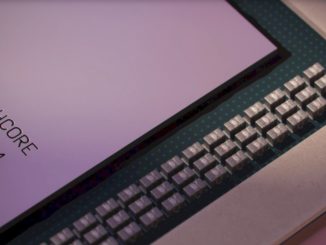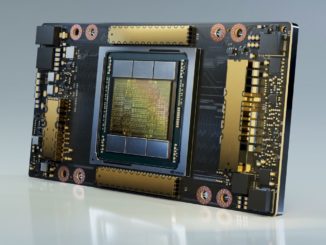
If you are going to be the full-stack, hardware-to-software-to-developer tools leader in the brave new world of AI, as Nvidia most certainly is, then you have to be able to adapt to the myriad environments that the emerging technology is threading itself through.
During his keynote address at Nvidia’s GPU Technical Conference 2025 this week in San Jose, company co-founder and chief executive officer Jensen Huang said the accelerated computing leader planned to do just that.
There was plenty on Huang’s menu about Nvidia’s “Blackwell” B300 GPUs and their upcoming successors, the “Rubin” family of accelerators, and other critical components like networking, which The Next Platform has already discussed. But there also was plenty that was rolled out that addressed the enterprise and the edge and the world of physical AI and, as the CEO pointed out, there were things from Nvidia for all of that.
“The cloud service providers, of course, they like our leading-edge technology, they like the fact that we have a full stack, because accelerated computing is not about the chip,” he said. “It’s not even about the chip and the libraries, the programming model. It’s the chip, the programming model, and a whole bunch of software that goes on top of it. That entire stack is incredibly complex. They also love the fact that Nvidia CUDA developers are CSP customers because, in the final analysis, they’re building infrastructure for the world to use.”
That said, while AI may have gained its momentum in the cloud, it’s not staying there.
“Now that we’re going to take AI out to the rest of the world, the rest of the world has different system configurations, operating environment differences, domain-specific library differences, usage differences,” Huang said. “AI, as it translates to enterprise IT, as it translates to manufacturing, as it translates to robotics and self-driving cars, or even companies that are starting GPU clouds they have their own requirements.”
He said AI and machine learning have reinvented the computing stack, from the processor through the operating to the applications, and how enterprises run and orchestrate them will be different. Rather than retrieving the data they want and then read it, enterprise workers will ask the AI system a question and it will give them an answer.
“This is the way enterprise IT will work in the future,” Huang said. “We’ll have AI agents, which will be part of our digital workforce. There a billion knowledge workers in the world. There will probably be 10 billion digital workers working with us side-by-side. AI agents will be everywhere. How they run, what enterprises run, and how we run them will be fundamentally different. So we need a new line of computers.”
That tends to start with hardware, in this case two personal AI supercomputers, the DGX Spark – formerly Project DIGITS – and DGX Station, Blackwell-powered desktop systems for inference and other tasks that can run locally or in Nvidia’s DGX Cloud or other accelerated cloud environments. DGX Spark is powered by a GB10 Grace Blackwell Superchip, which Nvidia said will deliver up to a thousand-trillion operations per second for AI fine-turning and inference.
DGX Station is a larger desktop powered by the GB300 Grace-Blackwell Ultra Desktop Superchip and containing 784 GB of coherent memory space, Nvidia’s ConnectX-8 SuperNIC, its AI Enterprise software platform, and access to the vendor’s NIM AI microservices.
The systems not only give enterprise users new tools for running AI workloads, but also are another avenue into the era of AI reasoning models, a step beyond AI agents in their ability to address and solve problems and miles away from the prompt-and-reply nature of ChatGPT and other AI chatbots.
“We now have Ais that can reason, which is fundamentally about breaking down a problem, step by step,” Huang said. “Now we have Ais that can reason step by step by step using … technologies called chain of thought, best of N, consistency checking, path planning, a variety of different techniques. We now have Ais that can reason.”
Nvidia at the Consumer Electronics Show in January unveiled the Llama Nemotron advanced agentic AI models and Cosmos Nemotron vision language models, making them both available as NIM microservices for developers to build AI agents that can understand language and the world and respond appropriately.
At GTC, Nvidia unveiled a family of open Llama Nemotron models with improved reasoning capabilities for multistep math, coding, decision-making, and the ability to follow instructions. According to Kari Briski, vice president of generative AI software for the enterprise at Nvidia, the vendor also is supplying datasets – comprising 60 billion tokens of Nvidia-generated synthetic datasets – and techniques to further help developers adopt the models.
“Just like humans, agents need to understand context to breakdown complex requests, understand the user’s intent, and adapt in real time,” Briski told journalists in a prebriefing before the keynote.
The reasoning capability can be toggled on and off and the Nemotron models come in three sizes, with Nano being the smallest and offering the highest accuracy on PCs and edge devices. Super models include high accuracy and throughput on a single GPU, while the Ultra model will run on multiple GPUs. Nano and Super models are available now, with Ultra coming soon, she said.
Among the additions to Nvidia’s AI Enterprise software platform is AI-Q Blueprint, another NIM-based offering that allow enterprise to connect proprietary data to reasoning AI agents. The open software integrates with Nvidia’s NeMo Retriever tool to query multiple data types, such as text, images, and videos, and allow for the vendor’s accelerated computing to work with third-party storage platforms and software, as well as the Llama Nemotron models.
“For teams of connected agents, the blueprint provides observability and transparency into agent activity, allowing the developers to improve agents over time,” Briski said. “Developers can improve agent accuracy and reduce the completion of these tasks from hours to minutes.”
Nvidia’s AI Data Platform is a reference design for enterprise infrastructure that includes AI query agents built via the AI-Q Blueprint.
In his keynote, Huang also talked about physical AI, an area that calls for integrating AI into physical systems to allow them to perceive and react to the real world and which he said could become the largest space in the AI market.
“AI that understands the physical world, things like friction and inertia, cause and effect, object permanence, that ability to understand the physical world, the three-dimensional world,” Huang said. “It’s what’s going to enable a new era of physical AI and it’s going to enable robotics.”
There were a number of announcements in this area, including Nvidia’s AI Dataset aimed at robotics and autonomous vehicles. Developers can use the dataset to pretrain, test, and validate models or for post-training and fine tuning foundation models. It includes both real-world and synthetic data the company uses for its Cosmos world model development platform as well as its Drive AV software, Isaac AI robot development platform, and Metropolis framework for smart cities.
The first iteration is available on Hugging Face, with 15 terabytes of data for robotics training now and support for autonomous vehicle development coming soon.
Huang also noted Nvidia’s Isaac GROOT N1, an open foundation model trained on real-world and synthetic data for humanoid robots and the result of Project GROOT, which the vendor unveiled at last year’s GTC.
Comments are closed.











Please don’t hate me for saying this but..
it’s GR00T, not GROOT.
GR-Zero-Zero-T
Or so the T-IOOO would like you to believe, as they stealthily roam around in the integer disguise of a harmless T-1000 … ! 8^p